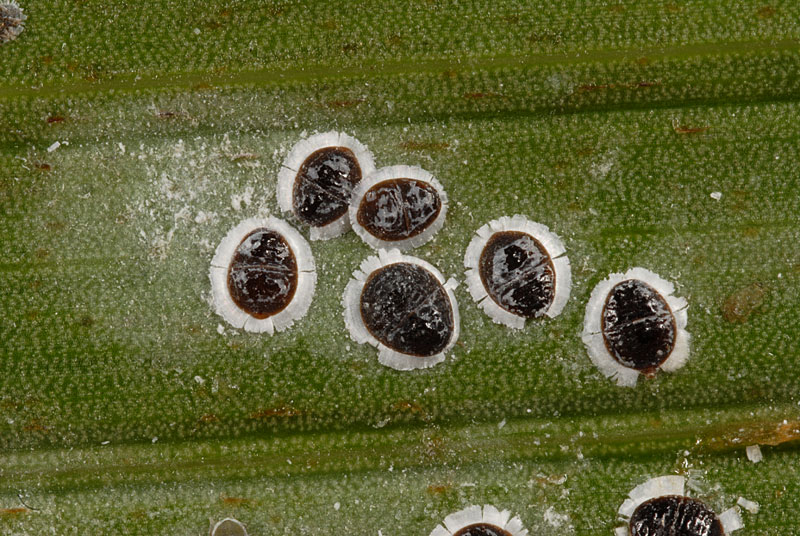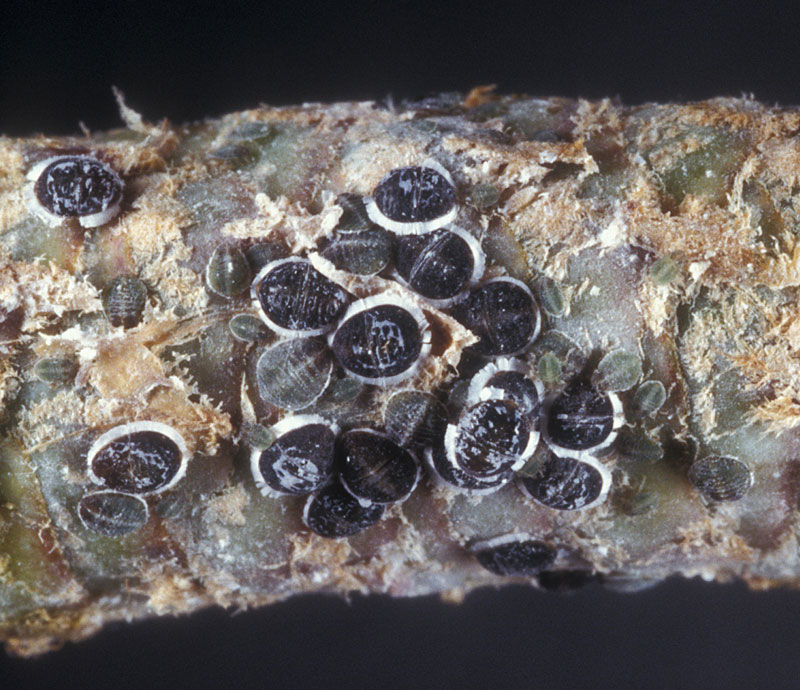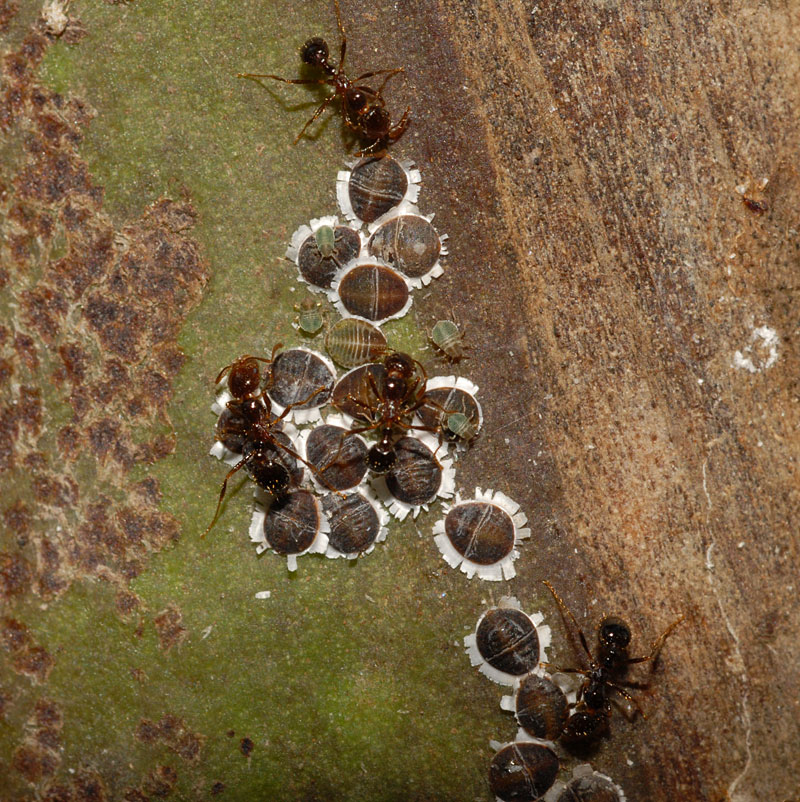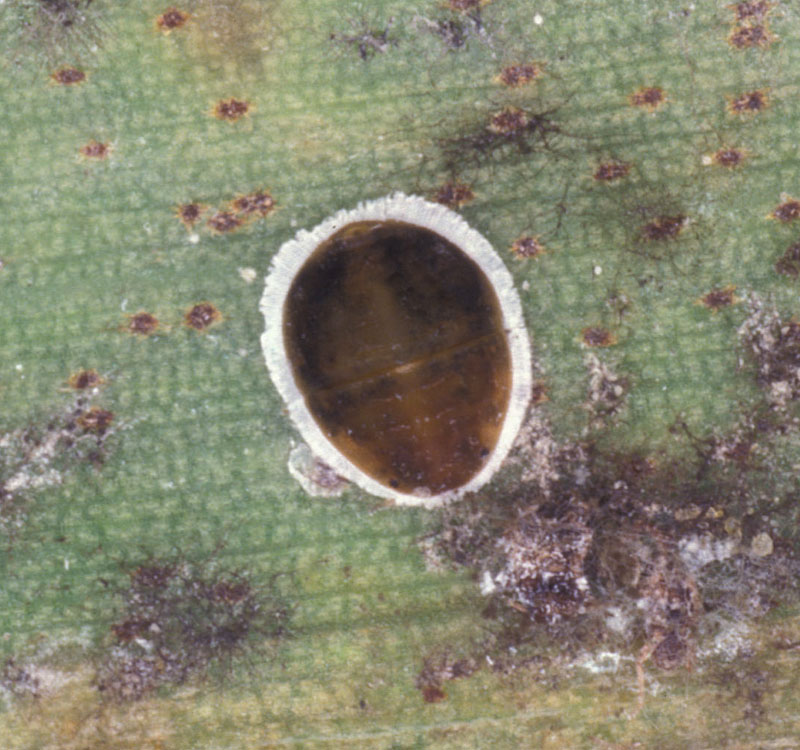Palm Aphids
|
palm aphid adults; Photo by Lyle Buss, University of Florida |
|
palm aphids, adults and larvae; Photo by Lyle Buss, University of Florida |
|
palm aphids with fire ants; Photo by Lyle Buss, University of Florida |
|
Cerataphis brasiliensis, adult; Photo by James Castner, University of Florida |
Rank & taxon
Genus Cerataphis [Family Aphididae]
Description
The only aphids that are known to commonly occur on palms are the palm aphids (Cerataphis spp.), which do not look like a "typical" aphid but look rather more like a scale insect. Adult palm aphids are 1-2 mm long, oval and slightly convex in shape, shiny dark brown or blackish in color with a white, waxy, threadlike fringe. Adults are wingless and have short legs that are hidden under the body. They are capable of moving, but they are mostly sedentary. The three immature instars are smaller and light green to olive in color with more noticeable legs.
Distribution
While aphids in general are typically temperate species, Cerataphis spp. appear to be primarily restricted to more tropical habitats, in correspondence with their host species. They are common on palms throughout the humid tropical regions of the world but are native to Asia. The genus includes from 3 to 10 species, depending on the source.
Biology/life cycle
In their native habitat, aphids of the genus Cerataphis are polymorphic and alternate between two host species, a dicotyledonous primary host and monocotyledonousmonocotyledonous:
(of a flowering plant) having a single cotyledon in the seed, as in palms, grasses, and lilies
alternate hosts. The aphids form galls on the dicotdicot:
group of flowering plants with two embryonic leaves, or cotyledons, in the seed
host, within which 3 generations are produced: 1) apterousapterous:
lacking wings
adults, 2) sterile second-instar larvae that act as soldiers, and 3) alatealate:
winged
adults which migrate to establish colonies on palms. Aphids are able to survive and reproduce on the monocotmonocot:
group of flowering plants having a single cotyledon in the seed, including palms, bananas, grasses, and lilies
host alone in the absence of the natural dicotdicot:
group of flowering plants with two embryonic leaves, or cotyledons, in the seed
host. Aphid reproduction on the monocotmonocot:
group of flowering plants having a single cotyledon in the seed, including palms, bananas, grasses, and lilies
host usually involves parthenogenesisparthenogenesis:
the production of offspring without mating - eggs develop normally without being fertilized
, live birth, and 'telescoping of generations,' where a female has parthenogenetically produced daughters and granddaughters developing inside her. When necessary due to changes in available resources, winged individuals will be produced that can fly to a new host plant to establish a new colony. When the dicotdicot:
group of flowering plants with two embryonic leaves, or cotyledons, in the seed
host is available, male and female aphids will be produced, mate, lay eggs, and form a new gall. In areas where the dicotdicot:
group of flowering plants with two embryonic leaves, or cotyledons, in the seed
host is absent, Cerataphis sp. live entirely on the monocotmonocot:
group of flowering plants having a single cotyledon in the seed, including palms, bananas, grasses, and lilies
host, the alatealate:
winged
forms are rarely seen, and they reproduce asexually. Aphids are capable of having many generations per year due to their prolific reproductive strategy.
Hosts
Palms: includes coconut palm (Cocos nucifera) as well as other palm species; in Florida, infestations seem to be more common on exotic ornamental palms than on native palm species
Other: primary host is dicotyledonous Styrax sp. in its native region in tropical Asia; other monocotyledonousmonocotyledonous:
(of a flowering plant) having a single cotyledon in the seed, as in palms, grasses, and lilies
hosts include bamboos, Pandanus spp., and orchids
Representative taxa on palms
Cerataphis brasiliensis and Cerataphis lataniae are the two species of palm aphids. Some taxonomists question whether these are distinct species or in fact a single species.
Additional comments
Cerataphis spp. generally occur in dense aggregations, typically on the young and unopened fronds, but also occasionally on the flowers and young fruits. They produce honeydewhoneydew:
the sticky, sweet secretion produced by sap-feeding bugs
, which supports the growth of sooty mold, and they are often tended by ants. Cerataphis spp. are virtually indistinguishable other than by microscopic examination of a slide-mounted individual; confirmation of identification should be done by an expert.
Cerataphis spp. are often confused with whitefly pupae.






